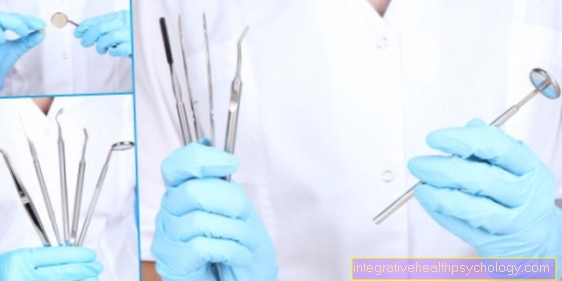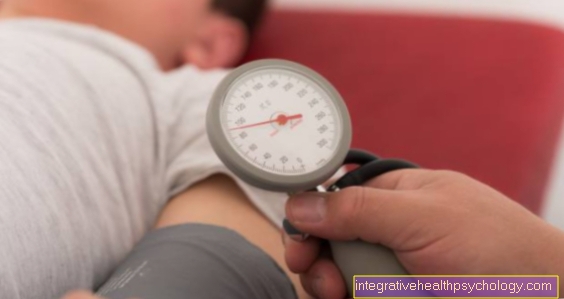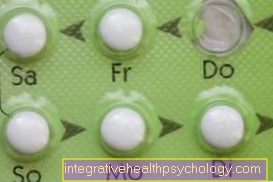Long-term blood pressure measurement
What is long-term blood pressure measurement?
Long-term blood pressure measurement is the measurement of blood pressure in a blood vessel over 24 hours. It is possible to measure blood pressure in different places. For a long-term measurement, the peripheral arterial pressure, the central venous pressure and the pressure in a pulmonary artery are possible.
In everyday clinical practice, peripheral arterial pressure is measured almost exclusively, usually the blood pressure of an artery in the upper arm. The procedure is routinely used in the hospital as a diagnostic method. The advantage is that it measures blood pressure in every day-to-day situation, including when you are sleeping or moving. There are normal ranges of blood pressure for every activity. This means that blood pressure that is too low or high blood pressure can be detected without a doubt.

Who needs long-term blood pressure measurement?
If a routine examination reveals increased blood pressure, the suspicion of permanent high blood pressure is reinforced. If this occurs in different situations on different days, the responsible cardiologist can arrange for a long-term blood pressure measurement. A reliable diagnosis of high blood pressure can only be made with the measurement.
Excessive blood pressure should definitely be treated as it can trigger many secondary diseases, especially diseases of the cardiovascular system. Older people are primarily affected by high blood pressure, but it can also occur in adolescence. High blood pressure is a widespread disease that many people in Germany still leave undetected and untreated. It is advisable even for young people to have their own blood pressure checked from time to time.
If a patient has frequent dizziness or fainting spells, blood pressure measurements can also be taken. A spontaneous drop in blood pressure in the middle of the day is suspected.
Read more on the topic: Blood pressure values - which are normal and which are not?
Sequence of a long-term blood pressure measurement
A specific day for the long-term blood pressure measurement is agreed with the cardiologist.
This day should be as everyday as possible so that normal blood pressure is also recorded. Particularly unusual activities or heavy sporting activities should not be undertaken on this day. During the day you will receive the device, which consists of a cuff on the upper arm and the corresponding measuring device that hangs around the neck. The cuff inflates every 15 minutes and slowly releases the pressure. At night, the device usually only measures every 30 minutes so that sleep is not too disturbed. After 24 hours, at the same time on the following day, the device is handed over to the practice and then evaluated by the doctor.
During the entire period, the patient should keep a record of the activities carried out within the 24 hours so that any increases or decreases in blood pressure can be traced. It takes a few days until all measurements of the 24 hours have been evaluated. On this basis, your doctor will be able to assess your blood pressure and discuss further examinations and therapies with you.
Evaluation of a long-term blood pressure measurement
The evaluation is carried out by the doctor in the following days after the long-term measurement.
The device, which recorded every 15 minutes during the day and every 30 minutes at night, displays the measured blood pressure values in a table. The doctor compares the values with the time and the activities specified in the log. From this, conclusions can be drawn as to whether the blood pressure was too low, normal or too high for the respective situation.
In between, incorrect measurements occur more frequently, especially at night when the arm with the cuff was in a position that is difficult to measure. To make the evaluation easier for the doctor, care should be taken to keep the arm as straight as possible, if possible also at night.
Normal blood pressure values
The ideal value the blood pressure is about 120/80 mmHg.
At less than 100/60 mmHg one speaks of a hypotension to one low blood pressure.
140/90 forms the Limit to a high blood pressure, a so-called "arterial hypertension". This can be graded again into different degrees of severity. From about 180/110 mmHg one speaks of one severe high blood pressure. This value is a resting value. It should only be measured after about 10 minutes of rest.
The first number of the blood pressure value describes the “systolic” blood pressure, which is measured in the blood vessel immediately after the heart pumping. The lower, second value ("diastolic blood pressure") is the lowest pressure of the blood flow that always occurs shortly before a heartbeat.
In sports the blood pressure rises sharply, but should not exceed a certain limit in a healthy person. The systolic value ideally should below 200 mmHg remain, even with heavy and persistent loads. This value can especially be found in a Exercise blood pressure measurement in practice respectively.
Find out about the standard values in our article Blood pressure readings
Showering during long-term blood pressure measurement
Showering during long-term blood pressure measurement should be avoided as far as possible, as there is a risk of damaging the measuring device from the water.
If it is absolutely necessary to shower during the 24 hours, the device can be removed for this purpose. Just keep in mind that the measurement is made every 15 minutes. Taking off, showering and putting on should therefore be completed between two measurements if possible.
Exercise during long-term blood pressure measurement
Operate them in their everyday life regular exerciseso it is quite permissible Not to do without it on the day of the measurement. In general, all everyday activities should be carried out normally so that the overall impression is not distorted.
However, it is more of a sport Rarity in everyday life, this as well as other stressful, extraordinary activities should be avoided. Many doctors advise no sport during the 24 hours to do. This is because endurance sports can have a direct impact on blood pressure. Half an hour Endurance sports can lower blood pressure for the next 10 hours. The blood pressure behavior during sport can be done well in practice by measuring the blood pressure under stress. For this reason, it is more advisable to pause sport during long-term blood pressure measurement.
Nocturnal measurement of blood pressure
For the overall assessment of blood pressure, it is particularly important to determine the values at night. At night, in healthy people, sleep leads to a lowering of the entire cardiovascular system. Healthy blood pressure regulation is also important for this. One speaks of a night reduction. The blood pressure should drop by about 10-30 mmHg compared to the blood pressure at rest when awake. In many people with high blood pressure, this nighttime reduction is no longer particularly pronounced. High blood pressure can keep you from sleeping and is to be classified as extremely harmful, especially with regard to the long-term consequences.
Long-term blood pressure measurement offers the rare opportunity to be able to measure blood pressure during sleep. However, it can be uncomfortable for the wearer of the measuring device during the measurement. Many patients complain of being woken up by inflating the cuff every half hour. You should try to survive the night as best you can despite the measurements, since the values during the night provide important information for the doctor.
Pain from long-term blood pressure measurement
If pain occurs during the measurement, this can be completely normal. The blood pressure values are usually so high that the measuring device has to build up enough pressure to obtain reliable values. In some cases, however, the measuring device is not adjusted to the appropriate height and can therefore not provide any values.
For this reason, the cuff is then excessively inflated, which leads to congestion, redness and pain in the arm, which can radiate into the fingers. If this is the case, you can simply replace the measurement with your own measurement that you write down. Then the blood pressure monitor is reattached and the next measurement awaited.
Can you do long-term blood pressure measurement without a cuff?
With a new measuring method, blood pressure can be measured without an arm cuff.
For this purpose, there is a small device on the wrist that works using pulse wave transfer time and an EKG. In addition, the activity is measured, which enables a better assignment of increased or decreased blood pressure values. Further advantages of this method are the measurement of all blood pressure values for every systole and diastole, lower susceptibility to interference and the less disruptive measurement during the night.
Can I go to work while measuring long-term blood pressure?
Since a long-term blood pressure measurement should show the blood pressure over a day during the daily activities, it is imperative to keep the daily routine as normal as possible.
A free working day that is spent on the couch or otherwise relaxed would only falsify the data and the data collected would be unusable. The only exception to this is sport and heavy physical work. If possible, this should be avoided during the 24 hours of the measurement.
Long-term blood pressure measurement costs
The costs of a long-term blood pressure measurement are covered by the statutory health insurance companies, provided that a doctor provides the indication.
If such a check-up is initiated by the patient, the costs must be borne by the patient. The costs for this amount to around 20 to 30 euros. A preventive medical check-up is financially worthwhile for the health insurance companies, since the costs incurred in the course of therapy for high blood pressure that is detected late can be reduced by a timely diagnosis.





























